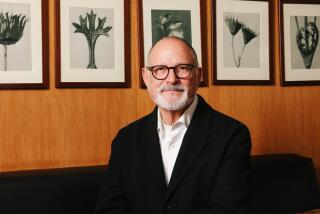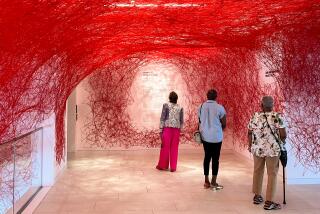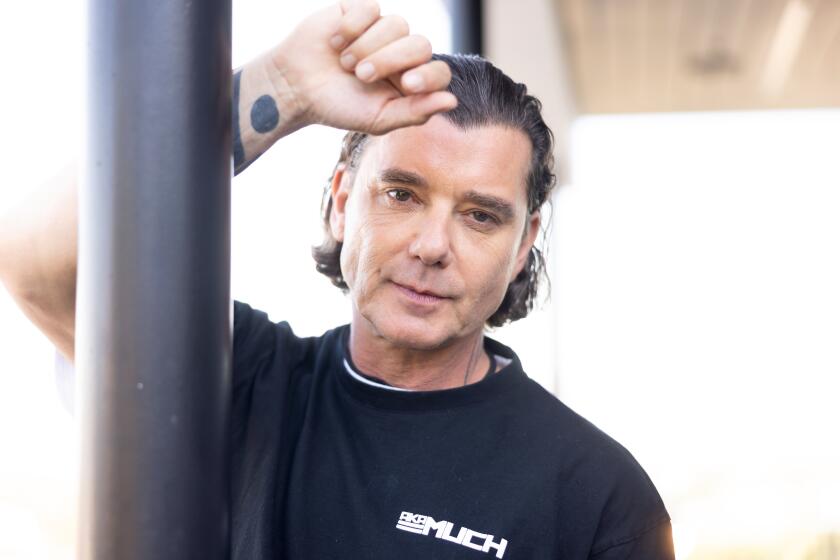ART / CATHY CURTIS : Newport Harbor Museum: 30 Years of Both Promise, Conflict
- Share via
After the abrupt and stormy departure of Newport Harbor’s first director, Thomas Garver--who left in the fall of 1972 to take a curatorial position at the Fine Arts Museums in San Francisco--the museum board decided that it needed someone with more substantial administrative experience to lead the museum into its second decade.
The job was not going to go to acting director Betty Turnbull, a longtime museum volunteer who had organized several ambitious and well-received exhibits, including “The Art of the Indian Southwest” (1971). Despite her demonstrated devotion to a museum founded by a hard-working group of 13 women, the board (which had just elected its first male president, Jerry Hayes) never seriously considered her for the top job.
“Betty was a nifty curator,” says longtime board member David Steinmetz, who served twice as its president during the ‘70s. “But we needed someone with a broader background to push the museum forward.”
That someone was James Bernard Byrnes, director of the New Orleans Museum of Art. When he came to Newport Harbor in June 1973, Byrnes was 56. He had begun his career in 1946, when the Los Angeles County Museum hired him to be its first curator of modern and contemporary art. After a stint at the Colorado Springs Art Center, Byrnes became associate director, and later director, of the North Carolina Museum of Art.
“I was a kind of dinosaur from an earlier period,” he now says wryly.
“We were a very, very avant-garde place,” recalls Phyllis Lutjeans, former gallery administrator at the museum. “We had been doing such wild stuff before--’Appearing/Disappearing Image/Object’ (in 1969), ‘San Francisco Performance’ (in 1972). Jim was a nice man, a bright man, but his heart belonged to Abstract Expressionism and the art of the late ‘40s and ‘50s. . . . He was a duck out of water.”
The low point of Byrnes’ struggles to comprehend and deal with the brave new world of contemporary art was his sudden cancellation of a performance by Chris Burden in 1974. A former fine arts graduate student at UC Irvine, Burden had a reputation for such highly provocative performances as “Five-Day Locker Piece” (in which he lived in a padlocked locker at UCI for five straight days) and “Shoot” (in which he had a friend shoot him in the arm).
Urged by his staff to show Burden’s work--which Byrnes says he thought was appropriate only for non-traditional venues--he grudgingly allowed “Do You Believe in Television?” to be performed in the main gallery of the museum.
Neither Byrnes nor Lutjeans (Turnbull was away from the museum at the time) knew what Burden was going to do. “Partly,” says Lutjeans, “we didn’t want to ask him. Surprise was often quite a part of his work.”
The night before the performance, Byrnes made a routine security check of the gallery. “A foot-and-a-half of hay was on the floor,” he recalls. “A couple of TVs were plugged in to terrible wiring. We would blow a fuse if we ran a hand-saw. I immediately pulled the wires. I panicked. I couldn’t get in touch with anybody.”
Worried about the Mark Rothko paintings from the previous exhibit stored in the back room (pending shipment to their owners), Byrnes returned to the museum later that night with his wife. They moved the hay away from the walls with push brooms and made sure the TVs were turned off. Byrnes experimentally lit a handful of hay in the men’s room and watched it flicker.
When Burden walked into Byrnes’ office the next morning, he was “very upset,” Byrnes says, claiming the director had “destroyed a work of art.”
“No, I haven’t,” Byrnes replied. “You had an audience of one--me--and I almost had a cardiac arrest.’ ”
Byrnes calls Burden “the “Evel Knievel of the art world. I admired him. The tragedy was, this is not something that museums can properly support.”
Burden explains that the hay was arranged in a straight line from the entryway of the gallery--where TV monitors were hung--to the back wall. His plan was to stand at the back of the gallery and make a fire with sticks and a bow, which he had been teaching himself during the previous weeks.
Viewers were not to be permitted in the gallery. From the doorway, they would not be able to make out just what he was doing. Their only clear view of him would be on the closed-circuit monitors.
“When I finally got a little ember burning, I would light the straw and it would burn toward the audience,” he says. “Before the burning straw got to them, they would see it on the monitors. . . . It was about television and the distortion of reality that we experience. You see a car crash on the highway, and you go home and see it on the news, and it’s more real in the news than in real life.”
“The idea wasn’t to burn down the museum, by any means,” Burden says. “Nor did I think there was any danger of that. . . . Straw is real slow-burning. It’s not like (viewers would have) had to run. . . . They had a lot of fire extinguishers and buckets of water. . . . I could understand their fear, (but) the Rothkos being there was totally unbeknown to me.”
Burden, who says he has no ill feelings about the aborted project, claims that he described the piece fully in advance to people at the museum who expressed interest in it (though he says he never spoke with Byrnes). Unlike the museum director, Burden feels that the piece would have benefited from the “tension” set up by the “formality of the museum,” which was more likely to cause viewers to “overreact.”
“Fire is a real emotional thing,” he adds. “That night was the one night that museum wasn’t going to burn (because of all the fire prevention equipment that had been assembled for the piece). That’s the irony for me.”
From the outset, Byrnes encountered several unpleasant surprises at the museum. He discovered that the museum had only a handful of people on staff, a volunteer curator, insufficient resources for the exhibitions he had hoped to develop, and trustees who kept an iron grip on the purse.
“There were no discretionary funds,” Byrnes says. “You had to ask permission (of the trustees) for everything you did.”
There were also other problems. “(Byrnes) had a very soft nature,” Lutjeans says, “but he had a very difficult time making decisions--daily decisions, little things.”
“Most of the staff thought I ought to be an administrator,” Byrnes says. “The trustees thought I ought to be out lecturing, getting funds and organizing exhibitions that could be sold (circulated to other institutions) to get us some money. I’m a traditional museum man. I’m used to the idea that we work with artists to (mount) exhibitions.”
“Jim was at an age when he wanted to relax and live on past experiences,”says Steinmetz. “He brought a lot to us. (But) our problem with him was that he did not bring to the job the energy to organize the exhibition program.”
Scrambling to fill the galleries while Turnbull took a well-deserved sabbatical from the museum, Byrnes learned that an exhibit of paintings by the recently deceased Rothko--whom the director had known personally--had been proposed before his arrival.
But the $3,000 budget for the show was laughably small. Byrnes needed twice as much to produce a catalogue (“We had to have a catalogue, come hell or high water”) and perform such routine tasks as setting up temporary walls in the gallery and covering some of the paintings with Plexiglas to reassure their nervous owners.
As Byrnes recalls, the trustees were displeased that he was obliged to raid the $20,000 operating budget to pay the bills for the exhibit.
Byrnes’ lasting legacy was his insistence that the museum become a collecting institution rather than simply an exhibition venue for art. The museum had already acquired the beginnings of a collection: 34 contemporary sculptures and paintings by such artists as Joan Miro, Franz Kline, Josef Albers, Richard Anuskiewicz and Gene Davis, which were donated in 1971 by AVCO Financial Services.
Byrnes told the trustees that “if they were going to use the name museum over the door, they had to take on the obligation of what a museum is.” How, he asked, could the museum expect to borrow works of art from other institutions if it was unable to lend works from its own collection?
At that time, Byrnes says, the post-1945 emphasis of the museum was not yet set in stone. He was dismayed when the trustees voted against acquiring works by turn-of-the-century French painter Henri de Toulouse-Lautrec from the estate of Newport Beach yachtsman Baldwin M. Baldwin. (In 1988, his widow donated the 98 pieces to the San Diego Museum of Art.)
Some of Byrnes’ exhibition plans also were met with a lack of trustee enthusiasm because they had little to do with contemporary art, he says, citing a proposed exhibit commemorating the William Copley Gallery (a pioneering modernist gallery in Beverly Hills during the 1940s), which was dismissed as “old hat.”
Byrnes was feeling increasingly beleaguered. “I was politically taboo,” he says. “I was violently opposed to Nixon. Most of my trustees were, if anything, the right wing of the Republican Party.”
By the mid-’70s, another type of politics had asserted itself at the museum. In 1969, the board of trustees was composed of 23 women (including the 13 founders) and only five men; by fall of 1974, there were 24 men and 17 women.
The men, says a longtime museum supporter, “bought . . . their wives houses, cars, jewels, furs, clothes, vacations. They expected absolute loyalty in return.” Female board members who didn’t toe the line were no exception.
Members of the tiny, virtually all-female museum staff often felt they were not treated as professionals by the powerful male trustees. One former staffer recalls meeting with members of the board to discuss problems the staff was having with Byrnes, but “all they did was pat us on the shoulder.”
Yet the gap between Byrnes’ expectations and the trustees’ never closed. In early October, while the Foulkes exhibit was still up, executive committee member Leon Lyon sent Byrnes a no-nonsense letter requesting a status report on upcoming exhibitions.
Two days later, Byrnes replied that he would resign at the end of the year, citing the impossibility of organizing six large exhibitions a year while dealing with the museum’s daily administrative duties.
The board was especially frantic to find a new director because the museum was about to make a huge leap--to designing and building a home of its own on two acres pledged by the Irvine Co. The pledge was contingent on the museum’s ability to raise all the funding for the $500,000 building. A $1 million endowment drive was also in the wings.
But finding a seasoned museum director who was willing to come to a small art museum with no national profile proved very difficult. The long search began in October and didn’t end until 1 1/2 years later, in April, 1976, with the hiring of Harvey West, the dashing young director of the Henry Art Gallery at Washington State University.
More to Read
The biggest entertainment stories
Get our big stories about Hollywood, film, television, music, arts, culture and more right in your inbox as soon as they publish.
You may occasionally receive promotional content from the Los Angeles Times.










